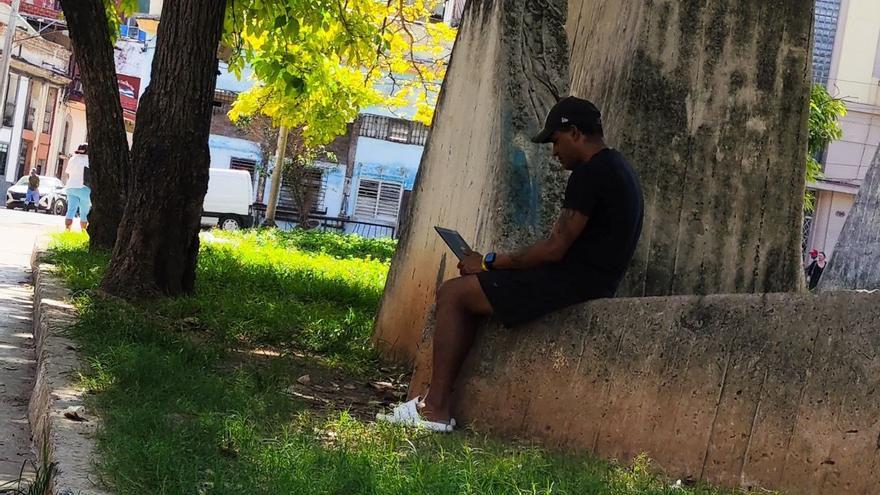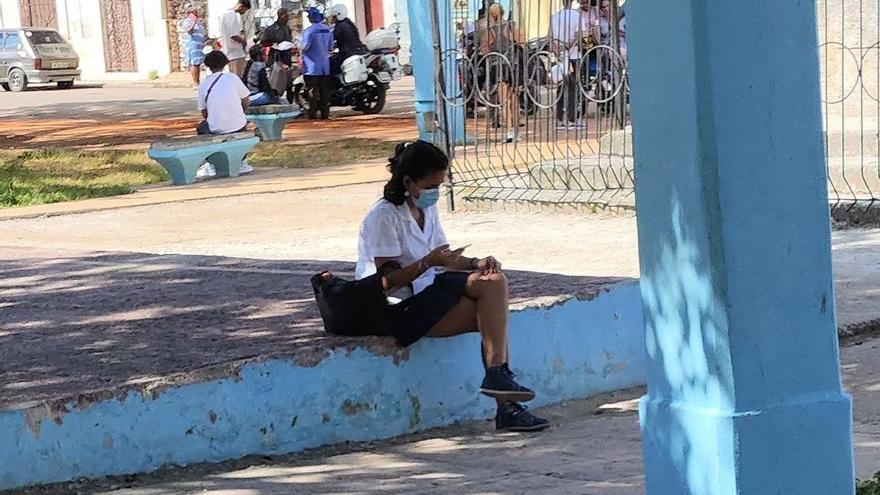
![]() 14ymedio, Natalia López Moya and Miguel García, Havana/Holguín, 25 October 2023 — It’s 11:00 AM and the only people to be seen in the park at the corner of Infanta and San Lázaro streets in central Havana are couple of people sitting on a bench and a man with his dog. The scene was very different a few years ago when, all day long, dozens of people were enthusiastically connecting to the wifi hotspot here. Now safety concerns, technical problems and the advent of web browsing on mobile phones has left the benches empty.
14ymedio, Natalia López Moya and Miguel García, Havana/Holguín, 25 October 2023 — It’s 11:00 AM and the only people to be seen in the park at the corner of Infanta and San Lázaro streets in central Havana are couple of people sitting on a bench and a man with his dog. The scene was very different a few years ago when, all day long, dozens of people were enthusiastically connecting to the wifi hotspot here. Now safety concerns, technical problems and the advent of web browsing on mobile phones has left the benches empty.
Forty-three-year-old Dunia was one of those who spent many hours sitting on a sidewalk curb or in the shadow of the park’s trees. In July 2015, when the first antennas were being installed and the public squares of the Cuban capital were becoming wifi hotspots, this sociology graduate felt like she could finally breathe. Now, she says, “it bears no resemblance” to what it was back then.
On Monday morning the connection speed in the park was barely 270 Kbps (kilobits per second). A little after 1:00 PM, two more people — a man and a woman — arrived and sat down to log on. “It’s no longer like it used to be,” says Dunia of the times when the park was full of people with their eyes glued to their screens.
On Monday morning the connection speed in the park was barely 270 Kbps
“At that point, I almost didn’t know what the internet was. I had only spent a few hours online at a hotel when my brother came to visit us from Madrid and he was staying at the Presidente,” she recalls. “It was all anyone in this neighborhood talked about. Even children in their mothers’ arms were glued to screens to see what they could see.”
Dunia made her first video call from this hotspot and saw the inside of the Madrid home where her emigré family lives. From here she reconnected via Facebook or Twitter with old friends scattered around the world. And from this corner she shared with her brother the sad news that their mother, who suffered from diabetes, had died.
“We used to spend hours and hours here but I don’t come anymore,” she admits. “Now that we have internet on our phones, I have more privacy and feel safer [connecting] at home. There have been incidents in this park where someone’s phone was snatched or their computer was grabbed while they were logging on.”
In the first year of widespread internet access, official media was filled with headlines praising the new hotspots. Initially, an hour of internet browsing cost 4.50 convertible pesos but Etecsa, the state telecommunications monopoly, kept reducing the price until it was as low as 1.50 pesos.
After years of pressure, Cuban officials finally allowed customers to access the internet from their mobile phones in December of 2018. With the demise of the country’s dual currency system, and along with it the convertible peso, the fee rose to 25 pesos. The technical problems, however, only increased. Since then, the web browsing service has been marked by ups and downs, outages when authorities get nervous about social media posts, deteriorating infrastructure and the exodus of tens of thousands of customers that have left a gaping hole in Etecsa’s balance sheet.

The wifi phenomenon filled Havana’s squares and parks with people, who captured the gaze of photographers, whose images filled the pages of dispatches from the island’s foreign press. Now it seems something is missing on strolls through La Rampa, the park at the interection of San Rafael and Galiano, large stretches of the Malecón, and areas surrounding hotels and important sites. The hundreds of people who once occupied these spaces are gone, a situation that is repeated throughout the country.
The surrounding area is full of MicroTik wireless routers that suck up the signal
“You can’t connect,” complains Julio, who lives near a park in central Holguín. “You get there, you see the network but you can’t log on because there’s no capacity even though there’s not a soul to be found,” he adds. “The surrounding area is full of MicroTiks [a brand of wireless routers] that suck up the signal.”
Savvy businesspeople have saturated the area near the park with these routers, which allows them capture to the signal, amplify it and charge residents for a service they can enjoy from their homes.
“For 500 pesos a month, I can provide you with home-based internet,” says Dany, a Holguín resident whose name has been changed for this article. “It’s much more convenient and less dangerous. But it’s true that, if you want to connect at the park, it’s going to be difficult because we have the signal. It’s rerouted through our equipment, which is more stable and more efficient that Etecsa’s.”
Dany manages a network made up of about twenty Nano and Mikrotik routers. A significant part the city of Holguín’s digital traffic relies on it. “We cannot create capacity where there isn’t any and some days are tough,” he admits. “Etecsa has not expanded the bandwidth of these wifi hotspots, so we have to work with what there is.”
In 2018 Etecsa was talking about more than a thousand wifi hotspots across the island, seeing them as a way to computerize all of Cuban society at twice the speed. Internet users, however, complained about the precariousness of these spaces, the inclement weather that affected the technology when used outdoors, and the threat of crime. They also complained, though less vociferously, that they wanted to be able to consume content that they could not enjoy in public.
When the power goes out, everything shuts down. The park’s antennas turn off and, without electricity, Etecsa’s telephone data towers go dead
With the country’s current energy crisis, blackouts are having a severe impact on Dany and her crew. “When the power goes out, everything shuts down. The park’s antennas turn off and, without electricity, Etecsa’s telephone data towers go dead. So whether you have a Mikrotik or not, you also get disconnected.”
Jessica, a young resident of Sancti Spíritus, notes that, though there is less enthusiasm for them, people still go online at the city’s public hotspots. “They’re downloading movies and TV programs to sell as video entertainment, or to use in their computer or cell phone repair businesses. It’s not crazy like it was before, when everyone was going to the park for wifi. There are those who still use it, not so much for personal reasons but to download big files.”
Jessica believes that the mass protests of 11 July 2021 (’11J’) were the kiss of death for these public hotspots. “They’re seen as threat because they have internet and people are physically congregating there.”
____________
COLLABORATE WITH OUR WORK: The 14ymedio team is committed to practicing serious journalism that reflects Cuba’s reality in all its depth. Thank you for joining us on this long journey. We invite you to continue supporting us by becoming a member of 14ymedio now. Together we can continue transforming journalism in Cuba.
